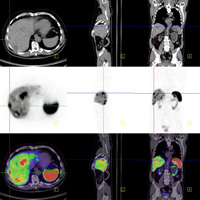Clinical Cooperation Unit Nuclear Medicine
Prof. Dr. Uwe Haberkorn (in ch.)
The Clinical Cooperation Unit (CCU) Nuclear Medicine is involved in multiple projects such as the planning and follow up of chemo- or radiation therapy, pharmacokinetic modeling of dynamic PET data, identification of new peptides with high affinity for tumor disease; the establishment of new endoradiotherapy approaches based on peptides and antibodies; the development of alternate panning strategies with phage and ribosome display using recombinant proteins, membrane fractions and cells; the design of combination therapy with endoradiotherapy and chemo-, immuno- or radiation therapy; and the establishment of new treatments for non-iodine-concentrating thyroid carcinoma. FUTURE OUTLOOK One major topic for the CCU Nuclear Medicine’s future research will be the identification of possible targets for new radiopharmaceuticals. For this purpose, the gene array data obtained from correlative PET and tumor specimen evaluations are screened for receptors and cell surface proteins. Following the identification of possible targets, the partners at the MPI Saarbrücken are using their FLEXx software, a small molecule docking software, to identify substances with a high likelihood of binding to the identified structures. The identification of new ligands will be one of the main areas of research in the laboratory. The group intends to apply biotechnology methods such as display (phage and ribosome display) of libraries consisting of scaffold proteins. This project addresses the identification of specific binders to targets overexpressed in a variety of tumors by using peptide libraries. We will concentrate on target structures identified either by literature research or by gene profiling data available at the campus. In the last 18 months we have started intra-arterial therapy with DOTATOC in patients with metastasized neuroendocrine tumors using 90Y, 177Lu and 213Bi. This program will be extended to other peptides/receptors. Furthermore, novel treatment strategies using radiolabeled benzamides in melanoma patients and PSMA ligands in patients with prostate carcinoma have been successfully transferred into clinical application.


